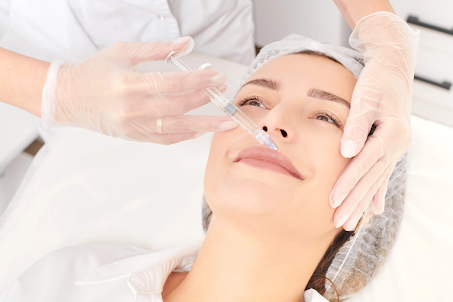How Do Chemical Peels Improve Skin Texture?
Chemical peels have been a cornerstone of dermatology for decades, offering a non-invasive solution to a wide range of skin concerns. By utilizing different acid-based solutions, chemical peels work by exfoliating the outermost layers of the skin, promoting cell turnover, and revealing fresh, rejuvenated skin beneath. This process significantly improves skin texture, making it smoother, more even-toned, and radiant.
What Are Chemical Peels?
Chemical peels are skin-resurfacing treatments that use acidic solutions to remove damaged outer layers of the skin. These peels vary in intensity, from superficial peels that target the top layer of the skin to deep peels that penetrate multiple layers for more dramatic results. The effectiveness of a chemical peel depends on the type of acids used, the depth of penetration, and the specific skin concerns being addressed.
How Chemical Peels Improve Skin Texture
The primary goal of chemical peels is to enhance skin texture by addressing various concerns, including roughness, uneven skin tone, and fine lines. Here’s how chemical peels work to improve skin texture:
 |
| Chemical Peels in Dubai |
Exfoliation and Cell Renewal
Chemical peels accelerate the natural shedding process of dead skin cells, allowing new and healthier cells to surface. This exfoliation process removes rough patches and uneven skin, resulting in a softer and smoother complexion. The increased cell turnover also stimulates collagen production, improving skin elasticity and firmness.
Reduction of Fine Lines and Wrinkles
Aging and environmental factors contribute to the formation of fine lines and wrinkles. Chemical peels, especially medium to deep peels, promote collagen synthesis, which plumps the skin and reduces the appearance of wrinkles. Regular treatments can help maintain youthful, supple skin over time.
Improvement in Skin Tone and Pigmentation
Uneven skin tone, hyperpigmentation, and sun damage can create a rough and dull appearance. Chemical peels effectively target pigmentation issues by breaking down melanin clusters and encouraging a more even skin tone. Over multiple sessions, discoloration diminishes, leading to brighter and more uniform skin.
Reduction of Acne and Acne Scars
Acne-prone skin often suffers from rough texture and scarring. Chemical peels containing salicylic acid or glycolic acid help unclog pores, reduce inflammation, and fade acne scars. The peeling process encourages new skin formation, smoothing out the texture and minimizing scars over time.
Minimization of Large Pores
Enlarged pores can make the skin appear uneven and rough. Chemical peels tighten the skin by removing debris and excess oil that cause pores to expand. With consistent treatment, pores appear smaller, and the overall texture of the skin improves significantly.
Types of Chemical Peels for Skin Texture Improvement
There are three main types of chemical peels, each varying in strength and benefits:
Superficial Peels
Use mild acids like alpha-hydroxy acids (AHAs) or beta-hydroxy acids (BHAs).
Gently exfoliate the top layer of the skin.
deal with minor texture issues, dullness, and mild acne.
Requires little to no downtime.
Medium Peels
Utilize stronger acids such as trichloroacetic acid (TCA).
Penetrate deeper to treat moderate wrinkles, pigmentation, and acne scars.
May cause mild peeling and require a few days of recovery.
Deep Peels
Contain phenol or high-concentration TCA.
Provide the most dramatic results by treating severe wrinkles, deep scars, and significant texture irregularities.
Require longer downtime but deliver long-lasting improvements.
Pre and Post-Care for Optimal Results
To maximize the benefits of a chemical peel and ensure smooth skin texture, proper pre and post-care is crucial.
Pre-Treatment Care:
Avoid excessive sun exposure and tanning.
Discontinue retinoids or exfoliating products a few days before the peel.
Keep the skin hydrated to minimize irritation.
Post-Treatment Care:
Use gentle, hydrating skincare products.
Apply sunscreen diligently to protect the newly revealed skin.
Avoid picking or peeling the skin to prevent scarring.
Follow a skincare routine recommended by a dermatologist to maintain results.
Expected Results and Timeline
The results of a chemical peel vary based on the type of peel and individual skin concerns. Superficial peels offer immediate brightness and softness with little to no downtime, while medium and deep peels show more dramatic improvements over weeks as the skin heals and regenerates. With consistent sessions, chemical peels significantly enhance skin texture, making it smoother, firmer, and more even-toned.
Are Chemical Peels Suitable for Everyone?
While chemical peels are highly effective, they may not be suitable for all skin types. Individuals with sensitive skin, active skin infections, or a history of keloid scarring should consult a dermatologist before undergoing treatment. Additionally, selecting the right type of peel based on skin type and concerns is crucial for achieving the best results without complications.
Conclusion
Chemical peels offer an effective and proven way to improve skin texture by promoting cell turnover, reducing imperfections, and enhancing overall skin health. Whether targeting fine lines, rough patches, or acne scars, chemical peels provide a solution tailored to various skin concerns. With proper care and consistent treatments, they help achieve a radiant, youthful complexion that looks and feels smoother. By understanding the process and benefits, individuals can make informed decisions about incorporating chemical peels into their skincare routine for long-lasting skin texture improvements.



Comments
Post a Comment